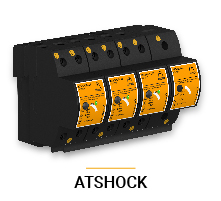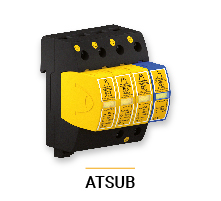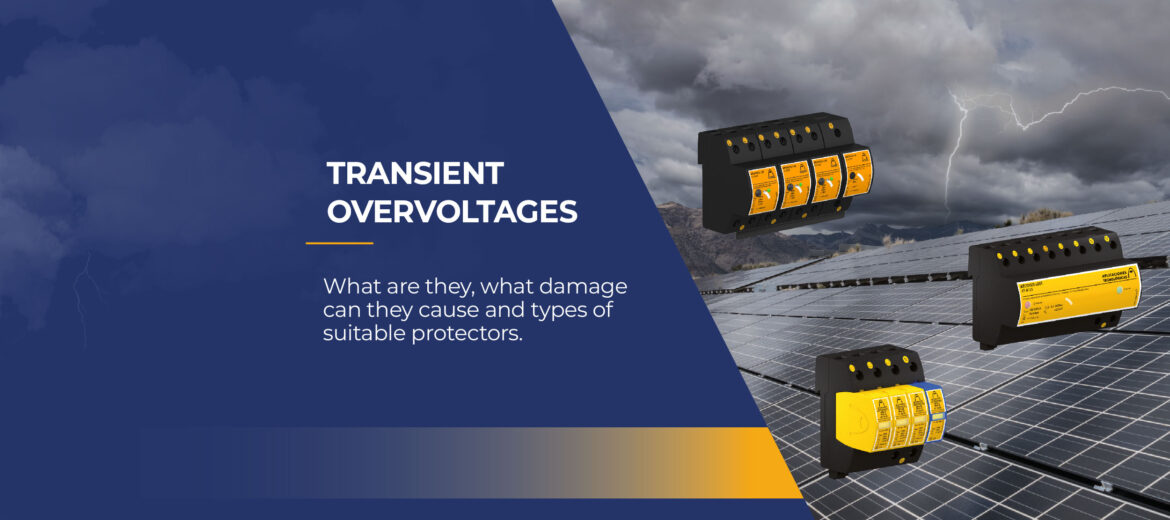What are transient overvoltages?
Surge protectors are devices whose main objective is to protect the electrical installation, conducting to ground voltages that are above a safe threshold before reaching electrical appliances. Aplicaciones Tecnológicas offers a wide range of surge protectors, both permanent and transient, for the protection of electrical installations. In this article, we are going to focus specifically on transient surge protectors.
The transient overvoltages, are very short duration increases in voltage, measured between two conductors, or between conductor and ground. These can be due to atmospheric electric discharges (lightning strikes) or to switching or fault processes (contact to earth or short circuit).
This overvoltage can cause premature aging of components and / or damage to equipment connected to the electrical network. Protection devices against transient overvoltages can be gas arresters, zinc oxide varistors, suppressor diodes, spark gaps, combinations of the above, etc. In addition, they can be divided into three types according to the level of protection they offer:
Transient overvoltages: types of protectors
TYPE 1 protector
Protects against direct lightning discharge. They are tested with a 10/350 µs current wave. They are usually installed in those places where the currents and electromagnetic effects of lightning are not attenuated. They are also necessary at the origin of the installation when the building has external lightning protection systems (lightning rods, Franklin rods, Faraday cages).
TYPE 2 protector
These limiters are tested with an 8/20 µs discharge current waveform, simulating the secondary effects of lightning. They are intended to limit transient overvoltages and divert current waves towards ground to limit the amplitude of this overvoltage to a value that is not dangerous for electrical installations and appliances. They are installed in those places where the currents and electromagnetic effects of lightning are already attenuated.
TYPE 3 protector
They protect against the most attenuated industrial surges. Tested with a combined current wave of voltage pulse 1.2 / 50 µs- and current 8/20 µs, simulating overvoltages already very attenuated. They are usually installed near the most delicate equipment or when they are more than 30 meters from the previous protector.
The most significant parameters for one of these types are:

Transient overvoltages: protectors Type 1, 2 and 3 from Aplicaciones Tecnológicas
Type 1: ATSHOCK
The protectors of the ATSHOCK series have been subjected to tests in official and independent laboratories as Type 1 and 2 protectors according to the UNE-EN IEC 61643-11 standard and GUIDE BT-23 of REBT (Low Voltage Electricity Regulation).
Main features:

- Double terminal connection for easy wiring (limited to 63 A).
- Made up of gas discharge tubes capable of withstanding very high currents.
- Can be coordinated with the protectors of the ATSUB and ATCOVER series.
- Short response time.
- Do not produce deflagration.
- Their activation causes no interruption in power supply.
- Great energy derivation capacity.
- Limits consecutive network currents.
- It has a test button to check the status of the protector. If the buzzer lights up protective green in good condition. If not replace. This indicator does not generate any operating current resulting from the status check and does not increase earth leakage during normal operation.
- Complies with IBERDROLA’s requirements for protection against type 1 overvoltages in the Centralization of meters.
- The ground connection is essential and that the ground connections of the entire installation are connected for the protection to be correct.
Type 2: ATSUB
Power supply protector lines type TT. Neutral-earth protection. Uc = 460 VAC (L-L). Imax = 40 kA. Up (In) = 1400 V. Up (1,2 / 50) = 700 V. 4DIN size. Tested and certified as a Type 2 protector according to the UNE-EN IEC 61643-11 standard and the GUÍA-BT-23 of the REBT.
Main features:
- Suitable for Category I, II, III, IV equipment according to ITC-BT-23.
- Pluggable modules that allow their replacement in case of breakdown or failure.
- Compact multi-pole protection.
- Made up of zinc oxide varistors capable of withstanding very high currents.
- Can be coordinated with the protectors of the ATSHOCK, ATSHIELD and ATCOVER series.
- Short response time.
- Do not produce deflagration.
- Their activation causes no interruption in power supply.
- Thermodynamic control device.
- They are installed in parallel with the low voltage line.
- The installation must be carried out without voltage in the line
- Ground connection is essential. For the protection to be correct, the earth connections of the entire installation must be connected, directly or by means of sparks, and their resistance must be less than 10 Ω.
Type 3: ATCOVER
3-phase, neutral and earth protector for three-phase 400V lines (L-L). Imax (8/20) = 30kA. Up = 900V. Tested and certified as a Type 2 + 3 protector according to the UNE-EN IEC 61643-11 standard and the GUÍA-BT-23 of the REBT.
Main features:
- Double terminal connection for easy wiring (limited to 63 A).
- Compact multi-pole protection.
- Common and differential mode protection.
- Can be coordinated with protectors of ATSHOCK, ATSHIELD and ATCOVER series.
- Short response time.
- Do not produce deflagration.
- Their activation causes no interruption in power supply.
- Great energy derivation capacity.
- Limits consecutive network currents.
- Potential free output for remote warning.
- They are installed in parallel with the low voltage line.
- Ground connection is essential. In order for the protection to be correct, the earth connections of the entire installation must be connected, directly or by means of sparks, and their resistance must be less than 10 Ω.
For more information about transient overvoltages protectors of Aplicaciones Tecnológicas, access the following link.
You can also attend any of our transient overvoltages webinars by clicking on the link below.
